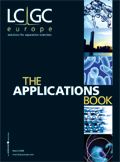Comprehensive 2D GC for Achieving Nitrogen Speciation in Middle Distillates
The Application Notebook
F. Adam,1 F. Bertoncini,1 D. Thiébaut,2 M.-C. Hennion,2 N. Lahoutifard3 and A. Addinall,4
1IFP, Vernaison, France, 2ESPCI, Laboratoire Environnement et Chimie Analytique, 10 rue Vauquelin, Paris, France,
3SGE EUROPE, 12 avenue du Québec, Courtaboeuf, France, 4SGE Analytical Science, 7 Argent Place, Ringwood, Victoria, Australia.
Introduction
The detailed molecular characterization of feedstocks and resulting products is a critical issue to better understand and improve hydroconversion processes.1 Neutral (indole, carbazole) and basic (aniline, quinoline and acridine) nitrogen containing hydrocarbons present in middle distillates at concentrations as low as 0.1–2.0% w/w poison catalysts used for hydrodesulphurization (HDS).2 They are also refractory to hydrotreatment processes preventing the efficient upgrade of middle distillates to transportation fuels.3 Conventional molecular analysis techniques fail to provide a detailed characterization of nitrogen compounds. As investigated here, comprehensive two-dimensional gas chromatography (GC×GC) appears to be a promising technique for overcoming these limitations.

Table 1: GCÃGC-NCD set-up.
GC×GC-NCD Set-up
Samples
A diesel cut was provided by IFP-Lyon, from cokefaction (diesel B, density: 0.880; total N: 1328 ppm; total basic N: 501 ppm; bp: 200–423 °C). A synthetic mixture of 14 relevant N-compounds (N-Mix) obtained from Chiron (Villeurbanne, France), Sigma-Aldrich (Lyon, France) and Acros (Noisy le grand, France) was prepared for GC×GC separation evaluation.

Figure 1
Results
Several secondary columns have been investigated for the separation of some reference nitrogen compounds occurring in middle distillates.1 Results are presented in Figure 1 and demonstrate that the combination of a polar and longer SolgelWax as the second dimension column to a first non polar BPX5 column allows the total separation when hyphenated.

Figure 2
Diesel B was then analysed using this column combination. The resulting GC×GC chromatogram is shown in Figure 2.
The results clearly show that GC×GC allows the comprehensive separation and precise quantitative analysis of nitrogen compounds by chemical class in middle distillates.
Conclusion
The enhanced peak capacity and sensitivity of comprehensive two-dimensional gas chromatography provided unequalled separation and identification of nitrogen compounds in diesel samples.
The proposed GC×GC method allows the accurate determination of basic to neutral nitrogen ratio. For the first time, the comprehensive determination of nitrogen compounds by family can also be reported.
References
1. F. Adam et al., J Chromatogr. A, 1148, 55 (2007).
2. Y. Briker et al., Fuel, 82, 1621 (2003).
3. G.W. Mushrush et al., Fuel Process. Technol., 61, 197 (1999).
4. J. Beens et al., J. Chromatogr. A, 919, 127 (2001).

SGE Analytical Science Pty Ltd
7 Argent Place, Ringwood, Victoria 3134, Australia
tel. +61 3 9837 4200 fax +61 3 9874 5672
E-mail: support@sge.com Website: www.sge.com

The Benefits of Custom Bonded Silica
April 1st 2025Not all chromatography resins are created equal. Off-the-shelf chromatography resins might not always meet the rigorous purification requirements of biopharmaceutical manufacturing. Custom bonded silica from Grace can address a wide range of separation challenges, leading to real performance improvements. Discover more about the latest innovations in chromatography silica from Grace, including VYDAC® and DAVISIL®.










